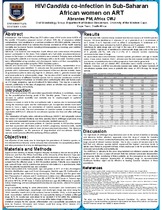| dc.contributor.author | Abrantes, Pedro Miguel dos Santos | |
| dc.contributor.author | Africa, Charlene W.J. | |
| dc.date.accessioned | 2014-04-13T20:44:26Z | |
| dc.date.available | 2014-04-13T20:44:26Z | |
| dc.date.issued | 2013 | |
| dc.identifier.citation | Africa, C.W.J. & Abrantes, P.M.D.S. (2013). HIV/Candida co-infection in Sub-Saharan African women on ART. South African Journal of Epidemiology and Infection, 28(3): 245 | en_US |
| dc.identifier.issn | 1015-8782 | |
| dc.identifier.issn | 2220-1084 | |
| dc.identifier.uri | http://hdl.handle.net/10566/1073 | |
| dc.description | 5th FIDSSA Congress 2013: Champagne Sports Resort Drakensberg, KwaZulu Natal, South Africa -
Poster Presentations. | |
| dc.description.abstract | INTRODUCTION: Sub-Saharan Africa has 23.5 million cases of HIV and is home to 92% of
the world’s HIV-positive pregnant women of whom 24% die of pregnancy related
complications. Oral candidiasis is a common condition in HIV-AIDS patients, caused by
commensal yeasts which may colonise the mucous membranes of the mouth causing
morbidity due to several factors including immunosuppression, smoking, poor nutrition
and the use of antibiotics.
Methods: One hundred and ninety-four South African and Cameroonian HIV-positive
women participated in the study. Only subjects who had white pseudomembranous
plaque on the tongue or visible oral candidiasis were included. Samples were collected
by scraping the patient’s oral mucosa and tongue with a sterile swab. Candida species
were differentiated using selective and chromogenic media and their susceptibility to
antifungal drugs was tested using the TREK Sensititre system.
Results and conclusion: One hundred and ninety-six isolates, representative of six
Candida species were identified. C. albicans was the predominating species, with C.
glabrata and C. dubliniensis being the more frequent of the non-albicans isolates. Azole
drug resistance patterns were very high for C. albicans, while C. glabrata showed high
resistance patterns to echinocandins drugs. The duration of ART could be associated
with the presence of different Candida species but no concrete conclusions could be
drawn concerning HIV/Candida co-infection when controlling for other risk factors such
as HIV stage, pregnancy, age and treatment for tuberculosis. This may be a cause for
concern, particularly in the case of pregnancy, where co-infection may pose a risk for
maternal morbidity and mortality. | en_US |
| dc.description.sponsorship | National Research Foundation of South Africa | en_US |
| dc.language.iso | en | en_US |
| dc.publisher | Infectious Diseases Society of Southern Africa, the Sexually Transmitted Diseases Society of Southern and the Public Health Association of South Africa. | en_US |
| dc.rights | © 2013 Africa, Abrantes. This is an Open Access article distributed under the terms of the Creative Commons Attribution License (http://creativecommons.org/licenses/by/3.0), which permits unrestricted use, distribution, and reproduction in any medium, provided the original work is properly cited. | |
| dc.subject | Candida | en_US |
| dc.subject | Women | en_US |
| dc.subject | HIV | en_US |
| dc.title | HIV/Candida co-infection in Sub-Saharan African women on ART | en_US |
| dc.type | Poster | en_US |
| dc.privacy.showsubmitter | false | |
| dc.status.ispeerreviewed | true | |
| dc.description.accreditation | Department of HE and Training approved list | en_US |

